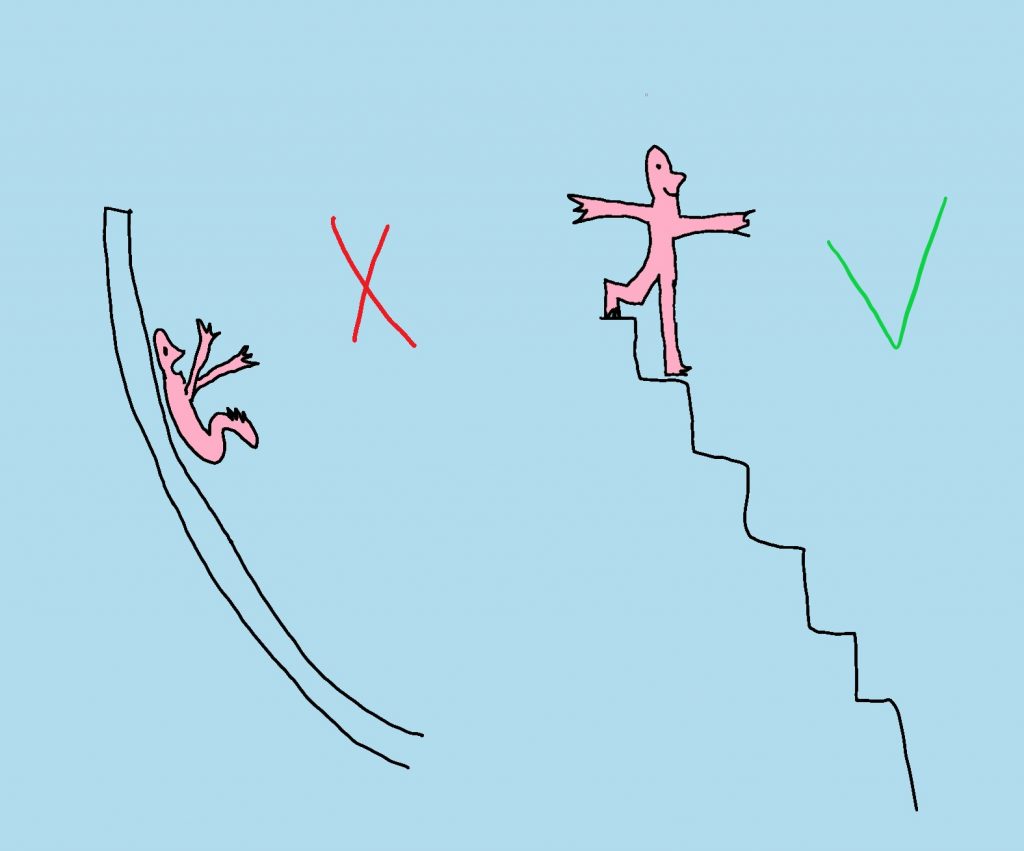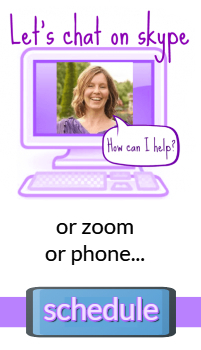Many people avoid healing childhood trauma because they’re scared of the emotional pain that might surface. They worry they won’t be able to handle it or that they’ll be stuck with chronic pain. If that’s you – even if just a little bit – I have good news for you. A responsible healing practice starts with learning practices that give you stability, not stress!
What does that mean? It means that you start with learning a practice that brings you inner peace, rest and rejuvenation.
If you’re the A-type go go go personality, you may believe that the rest and relaxation will come after the healing work. Yet, that’s like saying that you get to sleep and eat after training for and running a marathon. Could you imagine not eating nor sleeping for months, yet somehow training for and running a marathon? I sure can’t!
In other words, healing childhood trauma is a longish journey. You need plenty of rest, recovery and safety along the way.
Putting relaxation off as a kind of “reward” for when you “finish” healing can create several problems:
1. You don’t have the motivation or stamina to go through the healing process because you’re already exhausted even when you’ve barely started.
2. If you push on anyway, the healing journey itself can become an (unnecessarily) traumatic experience.
3. The pressure to “get the healing over with” can have you reaching for the worst kinds of quick-fixes.
These are the “healing solutions” that promise you the moon without much effort and without discomfort.
In other words, practices that are a complete waste of time and that can even set you back significantly on your healing journey. Some people will try to convince you that what is essentially “smoothing things over” is healing (it’s not).
4. Are people ever “finished” healing? (err, no)
Your body has an amazing storage capacity for holding stuffed pain and unresolved trauma. It’s highly unlikely that the healing work you see that needs doing now, is all there is.
However, reaching for “healing” as some kind of complete “end stage” creates all kinds of problems and illusions. Most importantly, this sets you up to fail by creating unrealistic expectations. Like: feeling like a loser because you should be “over this by now”. Or, simply refusing to do any more healing work because you had such high hopes for being 100% done by now (and as a result you backslide and undo some of your previous hard work).
5. When you try to “get healed” asap, chances are you forget/skip over prioritizing living now. You may put important things and activities you love on hold because you need to heal first.
Yet the truth is, you might spend the rest of your life doing some version of healing work. Will you wait that long to start living?
Real healing is like showering and brushing your teeth. You don’t try to get it over with in one go. You plan to spend a little time on it regularly because it’s part of being healthy and growing as a person.
I know that may sound discouraging, but if you’re a trauma survivor the most important thing is to make progress and unhook yourself from the pain of the past, at a pace that still makes life very worth living! Trying to rush to the “end” is just another kind of pressure that can worsen existing trauma symptoms. Instead of healing, you end up overwhelming yourself all over again.
The Key to a Sustainable Healing Practice
So, in short, I don’t recommend trying to “get healing over with asap”. Instead, you need to weave healing work into your life in a way that is truly doable and sustainable.
This starts with having a soothing, calming relaxation practice! Why? Because when you’re diving into painful past experiences and get triggered, the first fear that will surface (consciously or not) is that you won’t be able to handle the pain.
The truth of the matter is, it probably is too much to handle all in one big go. Which means: you need a way to dosage your healing work. And that means: you need a way to calm and soothe yourself when you feel overwhelmed and triggered. In other words, you need a practice that will help you press pause on the healing process and rest and recover.
I know at this point many people will go: “yes, yoga!” yet unless you’re comfortable rolling out your mat literally anywhere and anytime, you’ll need something a little more versatile and portable as well. This is where for many folks a practice of “deep breaths” comes in but in my own experience, a breathing practice is not enough to truly become calm.
In some cases, trying to regulate your breath can even make you more anxious, especially when you notice how stuck your breath feels and you’re close to a panic attack. It can feel like, on top of everything else going wrong, you’re also not breathing right! Gah!
So you need something simple and second-nature that you can truly use in daily life.
This is key because when you know you’ve internalized a practice like that, you can trust yourself to handle difficult feelings as they come up. After all, if it does get too much, you have a way to switch into rest and relaxation and simply take a break to recover, no matter where you are.
What is good healing work like?
Good solid healing work is not a matter of dragging endless crap to the surface and leaving you to wade through it somehow. Good solid healing work is:
- accessing a little bit of old emotional pain
- processing this pain (this doesn’t mean endlessly talking about it! the more important part is truly feeling it)
- resting and recovering
- having control over this process so that you know you can dosage how much you need to deal with at once. This includes recognizing the physical symptoms that come up when you’re overdoing it (your body will tell you, but you need to recognize the signals and listen to them)
I sometimes hear from people who are in some form of counseling or therapy and who go to sessions to drag trauma patterns to the surface, only to be left to deal with them pretty much on their own.
In theory, this is about going to therapy to “deal with” the past, only to – in practice – get super triggered and not know how to truly process or handle all the pain and fear that surfaces outside of the session! The therapy session gets the ball rolling, but then the client really doesn’t know what to do with that ball after, and just grabs on to whatever they can to try and manage and squash the pain.
In reality, dragging painful issues to the surface is not that hard. Any abusive relationship will do that for you “for free”! The hard part is knowing how to process and heal what surfaces in such a way that:
- You only need to do it once (you don’t go round and round the same painful hamster wheel over and over)
- You tone down any hyper – vigilance (instead of amping it up!)
- You get better at applying effective methods for dealing with trauma (so it gets easier and easier every time and you become less and less dependent on a mental health professional)
- You are truly healing and not just “coping”. When you go deep enough, true healing is possible, but when you just try to rid yourself of symptoms asap you’ll likely end up in “coping” mode, which means you’ll need to cope with the same pain over and over.
The Importance of Your Healing Limit
Sure, dragging things to the surface is part of the healing process. Yet, you also need to know how to process what surfaces, and how to calm things down when they get too much!
Most importantly, it’s counter-productive to drag more to the surface than you can process. Of course, it’s not possible to get that balance perfectly right, but it really should be doable most of the time, and not make you super super sensitive and feel lost and all over the place.
When the emotional pain is so huge and overwhelming that you don’t know how to get through the next hour, let alone the rest of the day, it’s logical that you’ll grab onto anything that will make you feel better. Yet, the whole point of bringing the pain to the surface was so that you could actually feel and heal it, not run away from it in terror!
In other words, when your “healing work” leads you to do more of a bad habit and run away from your feelings as fast as you can, it’s not very healing!
In fact, it’s counterproductive. If your healing work is so intense that you need your “bad habits” to get you through the day, then you’re pulling pain to the surface with one hand, and pushing it down again with the other hand. Meanwhile, you experience a lot of stress and don’t make real progress. Like a hamster on a wheel, you get very busy (and tired!) running in place and not really getting anywhere.
In my ideal world, all therapists, healers, psychologists, counselors and other mental health professionals would start with teaching clients healthy self-soothing techniques. Not drag all the pain to the surface and then throw you out to “process” on your own somehow.
That said, if you’re in therapy and you recognize yourself in this description: you’re grabbing on for dear life trying to cope with everything being pulled to the surface in sessions… please please please tell your therapist that it’s too much and that you can’t process it all.
It’s o.k. to slow down the process! In fact, doing so is much better than taking one step forward and two steps back!
(Note: in my ideal world, all clients would however also be knowledgeable and upfront about any mental illness. In the world of High Sensitivity there are quite a number of people who identify as sensitive and traumatized, yet who truly have Borderline Personality Disorder. Then – either in the know or not about their disorder – they expect everyone and anyone to walk on eggshells to not trigger any of their truly unpredictable sensitivities. BPD is not “just” High Sensitivity. It truly is a complex issue of its own and requires a mental health expert who specializes in BPD – that’s not me!)
True Healing is Vulnerable
True healing work requires deep feeling. This is vulnerable and tiring, yet also very effective to move through and on from the pain (instead of round and round the same patterns over and over).
To do this though, you need that surety that you have strong inner support. That you can count on yourself when you feel confused and wonky and that you have a way to stabilize yourself.
Because this kind of foundational practice is sorely lacking in many sensitive people’s lives, I’ve decided to offer a very specific calming, soothing, grounding and stabilizing practice as a stand-alone program. You can learn the ins and outs in just a month.
When you learn this first you will gain so much confidence and inner calm and stability for doing childhood healing. The idea of healing will stop feeling so daunting and will stop being something that can knock you upside down… because you know how to hit the breaks and pause when it’s a little too much.
Your body has carried your childhood pain for you all this time. You’re not required to heal it all in one big swoop. In fact, you can’t. It’s o.k. to take little healing steps!
When you have a soothing inner practice, you can turn that healing slide that seems endless and is scary, into a healing staircase: you take one step at a time, pause, and take the next step when you’re ready.
Yes, it’s slower that way, but the huge upside is that you do true healing work that lasts (instead of going down the healing slide in terror and being re-traumatized from the lack of control).

In Peaceful Presence you’ll learn how to make feeling peaceful, part of your daily routine. Because truly, inner peace shouldn’t be the end of your healing journey, you need it right at the beginning!
High Sensitivity and Trauma
Many Highly Sensitive People who struggle with their sensitivity have had traumatic childhoods.
They were either repeatedly told that they were too sensitive and that they should shut their sensitivity down (“toughen up”) or they shut down their sensitivity as much as possible of their own accord to try to deal with emotional abuse, physical abuse or sexual abuse. After all, when you can avoid feeling it, it makes it easier to deal with it. At least, for the conscious mind.
The long-term effects of pushing away the feelings of traumatic events is that now the unconscious mind carries all the burdens and the pain will start to seep out in all kinds of other ways. This can include chronic illness, and painful relationship patterns that are on repeat.
For those reading this who have a chronic illness: you need to go especially slow. Your body needs energy to just bare-bones function. While physical health and mental health tend to be intertwined in many ways, your physical body will still be the one that necessarily sets the pace for your healing. You can’t just “blast through” all the psychological trauma to speed up your physical healing!
How to Pace Your Healing
In my program Peaceful Presence I teach you a soothing, calming, inner peace practice and help you make it part of your daily routine. All in just a month (or a little longer if you want to take more time).
This allows you to pace any healing that you do by giving you a healthy “out”. A way to tone down any pain or chaos without having to resort to unhealthy coping techniques nor shutting down your sensitivity.
After all, true healing doesn’t mean blasting through old issues and pushing on. Rather, it means embracing more of who you are and developing the ability to be present to the parts of you that have gotten hurt over time.
Healing is not an operation, where you cut away everything that is hurting. Healing requires recognizing that the parts of you that are hurting, and that are “inconvenient” and “in the way” have an important voice, and wisdom to share. Yet accessing that requires a stable foundation. It requires staying calm while part of you wants to act out or is feeling out of sorts.
This is why I believe in cultivating that inner peace first. Yes, it’s good to “have” anyway. Who wouldn’t want to feel peaceful more of the time? Yet, it’s also a crucial support when you are trying to access parts of you that are deeply hurting.
Find out all about Peaceful Presence and how to enroll here.





















Comments on this entry are closed.